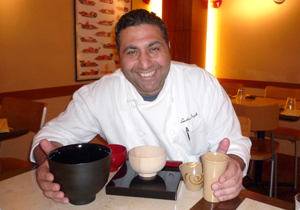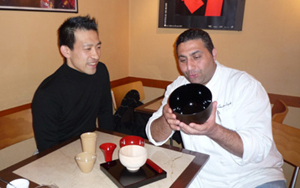"The Warmness of Japanese Lacquerware that attracts an Italian chef"
 Mr. Angelo Cozzolino
Mr. Angelo Cozzolino

Mr. Angelo Cozzolino who is an Italian chef from Ferenze (Florence) owns the Italian restaurant "Babbo Angelo (only Japanese website)" in Jiyugaoka in Tokyo. He is one of the biggest fans of Urushi lacquerware. As an Italian chef he has won the Internationale Kochkunstausstellung / Olympiade der Köche competition in 2000 and received 3rd place at Expo Gast in 2006. He won at both events for his cooking skills as well as the lacquerware he used to display his dishes. Today, his enthusiasm about lacquerware has expanded into events such as “Italian cuisine collaborates echizen urushi lacquerware”, which is held with Yamakyu Japanware Co., Ltd. It demonstrates a new usage of lacquerware that is now being recognized as an important part of the art of cooking.
We asked about his excitement and enthusiasm in using Japanese lacquerware.
Echizen Urushi: Why did you decided to come to Japan and when did you encounter Japanese lacquerware?
Mr. Angelo Cozzilino: I came to Japan 22 years ago to enhance my sport of Aikido, which is the art of weaponless self-defense. I came to stay with my brother in Japan who owned a furniture store here. I was introduced to Japanese lacquerware from a friend who was a collector of international art and antiques. His large collection of art included a “Japan Room”, which housed a large collection of Japanese art that included many pieces of Japanese lacquerware.
He suggested that Japanese Lacquerware would make great souvenirs for back home, and as I began to purchase them for gifts. I began to appreciate them and take an interest in real works of art. My first art purchase of Japanese lacquerware was a Wajima-nuri piece from Ishikawa Prefecture. It is beautiful 3 tiered jubako box and it was expensive.
When were you frist introduced to echizen urushi lacquerware?
 Mr. Angelo Cozzoline is talking about Japanese lacquerware with Mr. Yamamoto at his restaurant
Mr. Angelo Cozzoline is talking about Japanese lacquerware with Mr. Yamamoto at his restaurant

I learned echizen urushi through Mr. Yamamoto who focuses on the recognition and acknowledgement of traditional handcrafted lacquerware. We have known each other for couple of years now and have worked together on a special project involving an elementary school in Tokyo. We incorporated the teaching of echizen urushi lacquerware, which is entitled “Let’s be an Urushi expert,” along with my cooking class at the school. In fact, Mr. Yamamoto gave lacquerware bowls to an elementary school in Fukui to enhance the understanding of their local product. They use the lacquerware to serve food at lunchtime. We’ve borrowed the bowls for the school in Tokyo to serve the kids miso soup which they made in their class. We thought it would be important for younger kids to learn a traditional craft such as this and incorporate it into their everyday life. They even use it to serve the food they make in my class!
During the travel to Fukui, I also visited Mr. Yamamoto’s parents house. Everyone, particularly his father was very hospitable to me. As a matter of fact, I was allowed to observe the significant skills they use to create echizen urushi lacquerware. I was very lucky to have the opportunity to see the heritage that has been developed and passed on in Fukui.
What are positive aspects of echizen urushi lacquerware?
Echizen urushi can be produced with intricate and elaborate styles as well as simple and uncomplicated ones. This allows for the use of echizen urushi in many areas such as home, restaurants and hotels for heavy use. I have been deciding to serve Itarian-kaiseki (Japanese traditional tea-ceremony dishes) dishes using lacquerware at my restaurant.
What is your favorite lacquerware that you own?
I regularly use lacquerware with my family at home and my favorite lacquerware I have is a large salad bowl with a marble pattern on the inside bottom of the bowl. When I serve my special salad with balsamic vinegar sauce in the large lacquerware bowl, the colors of the salad and the lacquerware bowl create an amazing contrast and it looks so delicious on the table.
Also, I like to use lacquerware including the large bowl when I invite people to my house. My guests always compliment me on how wonderful the food looks using Japanese lacquerware.
Do you have any new ideas using lacquerware?
I have been practicing the few new ideas including one where I arrange desserts and other dishes on the cover of a jubako box. Another idea is incorporating the use of the shiro urushi lacquerware you brought today. These cups you brought all have a nice warm color to them and they would make a cappuccino or a café late look creamier and softer in appearance. What do you think? Nicer, yes?
 Cupccino and Cafe Latte in shiro urushi cups
Cupccino and Cafe Latte in shiro urushi cups

Why does Japanese lacquerware attract you?
As a chef, I understand that the aesthetics of food and the tableware it is served on is very important. Of course it depends on the food, but the glossy black and bright red appearance of lacquerware creates a luxurious appeal of the food, especially desserts. That is why I displayed my candy making artwork on lacquerware at Expo Gast in 2006. The rich appearance is not the only attraction of lacquerware, but also the texture of lacquerware, which can express softness and warmth.
Though I’m not Japanese I do like to eat rice using lacquerware. You may be surprised on how lacquerware makes rice seem sweeter to eat. Once you have experienced this, it is difficult to quit eating rice using lacquerware.
Originally lacquerware was basically made of wood. I think people are comfortable using wooden dishes because everywhere in the world people used to eat from wooden bowls. There is a famous Italian traditional food called polenta. It is a thick paste made from cornmeal. Polenta can be cooked many different ways, but the traditional way to serve polenta is to pour it into a deep indentation carved into the center of a big wooden table where people would gather around to enjoy it. Wooden tableware was and is easily found in every country and in Japan it is lacquerware that has a long history which was developed originally from wood.
May I have your comment on Japanese lacquerware?
Even though lacquerware is a wonderful Japanese culture, the use of lacquerware has decreased in Japan, which is very sad. For this reason, I agree with what Mr. Yamamoto is doing now as an echizen urushi lacquerware maker. He is planning new projects to encourage the continuation of this Japanese heritage. I believe that the remarkable characteristics of Japanese lacquerware should be recognized throughout the world.
Interviewed date: 8th February, 2010
